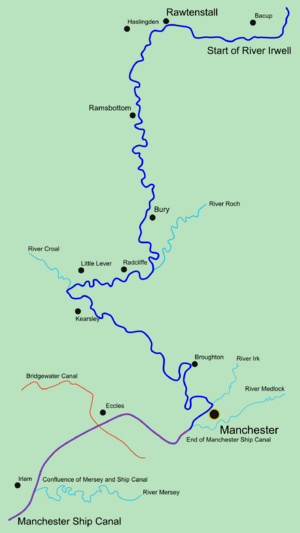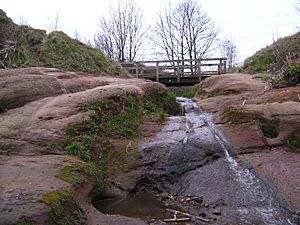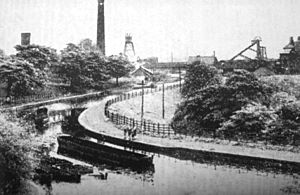Irwell Valley facts for kids
The Irwell Valley is a special place in North West England. It stretches from the Forest of Rossendale all the way through the cities of Salford and Manchester. The main river flowing through this valley is the River Irwell, and it's joined by the River Croal.
Contents
How the Valley Was Formed (Geology)
Millions of years ago, shallow seas covered much of south-east Lancashire. Over time, mud and sand settled at the bottom of these seas. These layers eventually turned into different types of rock like shale (a soft rock), sandstone (made from sand), and gritstone (a rougher sandstone). You can also find New Red Sandstone and Manchester Marls here.
Later, during the Ice Age (called the Pleistocene epoch), huge sheets of ice called glaciers moved across the land. As they melted and moved away, they left behind sand, pebbles, and a mix of clay and rocks called boulder clay. These materials formed hills and ridges, giving the Irwell Valley its shape.
One important spot is Ashclough, a 5.8-hectare (14.3-acre) area. It's a Site of Special Scientific Interest (SSSI). This means it's a very important place for studying geology. It shows a special rock layer called the Ashclough Marine Band, which helps scientists understand the ancient environment of Great Britain.
The Valley's Industrial Past
During the Industrial Revolution, many factories and mills were built along the River Irwell. This area became a hub for different industries. There were cotton mills, coal mines, and places that printed, bleached, or dyed fabrics. Chemical works and paper factories also popped up.
One famous coal mine, Wet Earth Colliery, was located in the valley at Clifton. Many bleach and dye works, like Lever Bank Bleach Works, were also here.
To move goods around, many canals were built. The biggest one was the Manchester Ship Canal. Even though railways later replaced many smaller canals, parts of the Manchester Bolton & Bury Canal still exist. There are even plans to fix it up for people to enjoy.
Sadly, all this industry caused a lot of pollution. By the 1850s, the River Irwell was so dirty that almost no wildlife could live in it.
However, people started trying to clean up the river in the late 1800s. Groups like the Mersey and Irwell Joint Committee were formed. They told local towns to clean their sewage and factories to stop polluting. Over the years, different groups took over this job. Since 1974, there has been a steady improvement in the water quality. Today, fish and other wildlife are slowly returning to the Irwell!
Local Wildlife and Plants
Some waste from industries, like mining spoil or chemicals, was dumped in the valley. For example, waste from making soda ash was left at Nob End, near Bolton, and Lower Hinds in Bury.
Over time, this waste changed into calcium carbonate. This created a perfect environment for special plants that like limey soil, called calcicolous plants. These plants are rare in this area because most of the soil is acidic.
Other plants, like giant hogweed and Himalayan balsam, which are not native to the area but escaped from gardens, have also added to the variety of plants in the valley. Nob End was made a Site of Special Scientific Interest in 1988 and a Local Nature Reserve in 2000.
The M60 also passes through the valley. The bridge at junction 16 (A666) in Clifton is a summer home for over 100 Daubenton's bats!
Irwell Sculpture Trail
The Irwell Sculpture Trail is one of the biggest public art projects in the UK. It's also the longest sculpture trail! It's a beautiful walking route, about 30-mile (48 km) long. It follows the Irwell Valley Trail from Salford Quays up to the moors above Bacup. Since 1987, more than 30 pieces of art have been placed along the trail by artists from the local area, the country, and even around the world.




